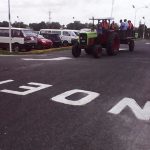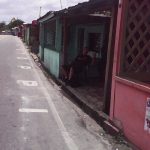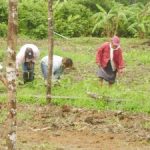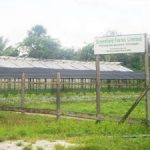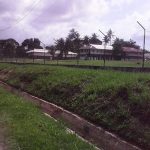I was definitely relishing in the lush blur of foliage and ‘other greenery’ as the minibus sped along the East Bank Demerara Highway. In no time I was nearing my destination and when the vehicle turned into the appealing village called Timehri, I was totally enthralled and taken back by its mystic beauty.
How I marvelled at the almost dense gathering of threes and other vegetation. My breath stuck in my throat momentarily as I gazed in awe at the intriguing manner in which houses were scattered strategically in the sprawling, mesmerising valleys.
I must admit that I was bit shocked that to discover that the roofs of some houses in the valley that surrounded the Cheddi Jagan International Airport (CJIA) were just a few yards from the road shoulder, and in my mind, all I could visualise was the dreadful results, should a vehicle skid off the road and landed on those ‘house top’s. But I must admit that the scenery is indeed beautiful.
Timehri is a village in Guyana located 41 kilometres to the south of the nation’s capital Georgetown. The name “Timehri” is an Amerindian word meaning “paintings and drawings on the rock” It is the home of CJIA which is our major international airport. It is also home to the South Dakota Circuit where numerous international competitors meet and participate in annual motor racing events.
As we landed in the village I almost doubled over with laughter as taxi drivers operating close to the airport tumbled over each other as they sought to be the first to pounce on the passengers getting off the Georgetown bound buses. And there indeed quite a fuss created when as they strived to see who would be the most fluent, and well mannered driver to be able to entice a journalist to have him use their car for the tour around the village.
We were certainly impressed with the breath taking allure of Timehri, but it was the fresh, pure breeze we gulped in with eager anticipation that really added ‘travelling spice’ to our visit. The thunderous drone of aeroplanes leaving and arriving at the airport seemed to engulf one with a feeling of ‘electric excitement’ that made it difficult to leave the village after.
Well most naturally I got off at CJIA and was surprised at the large number of fast food stalls and other snacks outlets that were situated just a few years from the port of entry. So naturally I began talking to the proprietors who eagerly engaged me in conversation.
Many of them had resided for many years in Timehri so information came to me abundantly.
Outstanding features
Aside from its preserved natural beauty Timehri was certainly a location where the bustle and hustle of residents, visitors and those passing through created an unrelenting ‘busy atmosphere’ to the settlement. What was noted for a fact is that this area possesses some outstanding features which made it the location that every one wanted to visit at one time or another.
Among those features was CJIA which was quite an attraction to the eyes and senses.
CJIA, formerly Timehri International Airport, is located on the right bank of the Demerara River in the city of Timehri, 41 kilometres (25 miles) south of Guyana’s capital, Georgetown.
History
The United States obtained rights to locate military facilities in British Guiana as part of the Destroyers for Bases Agreement with the United Kingdom in 1941. On 14 June 1941, the first United States Army forces arrived to survey land for a bomber airfield near Georgetown.
Atkinson Field was built 28 miles (45 km) from Georgetown on 68 acres (28 ha) of land formerly known as Hyde Park, on the Demerara River. The forest was cleared and hills were levelled and a long concrete runway was constructed. On June 20, 1941 the airfield officially opened with the activation of a weather station. The station was named after Lieutenant Colonel Bert M. Atkinson, a United States Army Air Service World War I aviator. Colonel Atkinson was the commander of the 1st Pursuit Wing on the western front in 1918. Colonel Atkinson retired from the Army in 1922 after a distinguished career and died on 27 April 1937.
The mission of the station was the defense of the colony against Nazi U-Boats. The airfield was also a major staging point for American aircraft crossing the Atlantic Ocean heading to the European Theatre on the South Atlantic transport route.
In 1965 and 1968 additions were made to the airport facilities. On 1 May 1969 the Atkinson Aerodrome was renamed the Timehri International Airport – “Timehri” is a Carib word for rock motifs located deep in the Guyana hinterland that pre-date the arrival of Europeans in the New World. The airport featured murals employing Amerindian motifs by Guyanese painter Aubrey Williams.
In March 1997, following the death of President Dr. Cheddi Jagan, the government decided to rename the airport the Cheddi Jagan International Airport. The proposition to rename the airport was proposed in the Parliament (National Assembly) by the then Minister of Amerindian Affairs, Vibert De Souza, who noted that it would be a fitting tribute to a man who had spent his life committed to the betterment of Amerindian people and fighting for the freedom and unity of all Guyanese. A plaque bearing the new name was unveiled on May 21, 1997 by the Prime Minister, Janet Jagan.
The Cheddi Jagan International Airport is undergoing a 150 million-dollar modernisation and expansion. The runway will be extended to about 11, 000 feet and new terminal with 8 air bridges is being built. This is expected to be completed by 2016.
The upgrade and expansion project comprises a new terminal building measuring 16,000 square metres, which will have eight passenger boarding bridges, two elevators; CCTV and departures control systems. The project also involves the extension of the airport’s main runway by 3500ft to a final length of 10,800ft, and the construction of eight international parking positions including a dedicated position for cargo aircraft.
The airport sits at an elevation of 95 feet (29 m) above mean sea level. It has two asphalt paved runways: 06/24 measuring 7,448 by 148 feet (2,270 m × 45 m) and 11/29 measuring 5,002 by 148 feet (1,525 m × 45 m). The terminal has six ground level gates.
Airlines Destinations
Airlines operate from this facility with destinations such as Miami, Port of Spain, Toronto-Pearson, and seasonally to Barbados via LIAT. The Copa Airline of Pana City will begin operations here on July 11, 2014. That aside we have recently acquired the services of Fly Jamaica Airways Kingston, Toronto-Pearson, while Insel Air Aruba begins operations on June 18, 2014) There are also Surinam Airways (Paramaribo, Miami), ABX Air Miami, (Port of Spain), Amerijet Miami, (Port of Spain), Caribbean Airlines Cargo (Miami, Port of Spain), and a few others.
South Dakota Circuit
South Dakota Circuit is a permanent motor racing track in Timehri, behind the Cheddi Jagan International Airport, Guyana. It is operated by the Guyana Motor Racing & Sports Club. The circuit hosts national circuit racing including the GMR&SC Skyline Mortgage Caribbean Race of Champions and various drag racing events.
South Dakota rebuilt
It was a daunting task but it was attacked with relish by those involved in this very gruelling project.
To start with, a special fund-raising committee, headed by motor racing enthusiast Sir Shridath Ramphal, and including Kit Nascimento and Alec Phillips and several others, lobbied local businesses for donations – raising some $200,000 (a grand sum in those days) to buy the bitumen from Shell Antilles Guianas Ltd. They got enough to cover two miles of roadway (at a greatly reduced price) and with the Ministry of Works providing equipment and a road engineer to design the curves, the job was done by October 16, 1970.
To mark the achievement the GMRC unveiled a plaque at the launching ceremony, inscribed with the names of the companies that helped. Dean Delamont returned and pronounced the facilities OK – issuing the club with an RAC International Track Licence, affiliation to the RAC and the provision of accident insurance for competitors and spectators alike.
The November 1970 meeting was the best ever – attracting some 15,000 spectators. It saw Team Speedbird return with Crabtree, in addition to teams from Antigua, Barbados and Trinidad. Team Guyana was led by President Eric Vieira in The Beast’s first appearance.
That meeting in November 1970 even got a whole page write-up in the prestigious magazine Autosport by Peter Burn who accompanied the UK team. It also set the format and dates for regular visits by Team Speedbird – coming either in early March (before the start of the UK season) or November (at season’s close) every year until 1980. For many, the period 1970-1975 represented the halcyon years of the sport with Poole and Spice being regulars, bringing a host of interesting cars to these shores.
The oil crisis
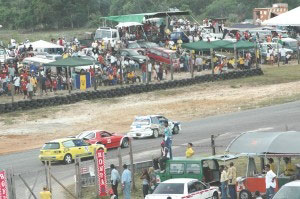
Around 1973 the oil crisis hit the world and even though motorsport slowed in the UK, Team Speedbird kept coming, bringing some of the UK’s best to Guyana and the Caribbean. Richard Longman (Mini-tuner extraordinaire) raced against Gordon Spice (Mini-racer supreme) in March 1975 (Longman won) and also to visit were Jenny Birrell, Barry Foley (Auto Sport cartoonist), Bob Howlings (of Cheshire Sports Cars fame), Barry ‘Whizzo’ Williams, U2 Clubman racer Bob Lamplough, power boat racer Steve Castagne and the larger than life Derek McMahon. The Caribbean produced its stars too, while Roy Taylor, Eric Vieira and even David Reid defended Guyana’s honour in their Jardim-built Terrapins, along with the U2s of Tom Wilson and Rod Grimes-Graem.
Greenfield Farms at Timehri
This facility is quite a dream come true for the owners and even for all Guyanese at large. At this farm folks are using advanced agricultural technologies to cultivate non-traditional crops. Greenfield Farms is at the forefront of revolutionising local farming practices to boost overseas exports.
There you can find zucchini plants on a plant bed which is covered with plastic mulch to prevent the growth of weeds.
The state-of-the- art-facility, located at Timehri, East Bank Demerara, is a project facilitated by the United States Agency for International Development/Guyana Trade and Investment Support (USAID/GTIS) project. It was conceived by four New York based-Guyanese who decided to establish a state-of the art agricultural farm after attending an investment seminar. The National Agricultural Research Institute (NARI) has been taking advantage of the technologies offered by the farm in the form of research and tours so that the benefits of modern technology in agriculture can be utilized.
Several plots (plant beds) on the farm are equipped with greenhouses and shade houses while a few plots are opened to the elements.
Folks there have noted that the design is intended to give local farmers a visual understanding of the advantages of using agricultural technology. Most of the plants cultivated at the farm are not commonly harvested in Guyana. Some of them are broccoli, butternut squash, purple cabbage, Dalia melon (a variety of watermelon), plum/cherry tomato (varieties of tomato), cauliflower and zucchini.
Some of the plants are allowed to undergo a trial run and if the crop is successful, the farm will continue to cultivate such crops. The farm is also equipped with a nursery, which houses several seedlings which are later transplanted into the earth within two weeks. Crops such as purple cabbage and cauliflower are high items in the nursery.
According to officials there the farm’s irrigation system utilizes water from the Demerara River. Water is pumped from the river into a reservoir which is located at the rear of the farm. A high-powered pump, which is connected to a configuration of pipes, pumps water from the reservoir into the pipes. Before the water enters the pipes it passes through a filter, which limits the presence of particles in the water. The pipes are connected to several drip lines which run parallel to each plant bed (plot).The drip lines are several hose-like lines which are made with small holes. Valves which are connected to the pipes are then turned on so that the plants can be watered. Fertilizer is also fed to each plant using this system. However, there is an injector pump which is also connected to the system within which chemicals and fertilisers are injected.
A few plant beds at Greenfield are equipped with plastic mulches. The reason for using plastic mulch is to prevent the growth of weeds, but there are also several beds without plastic mulch at the farm.
The plant beds at the farm are of varying lengths. They range from 150ft to 260ft in length and they are as wide as 20ft. The greenhouses and shade house are of similar length. The UV (ultraviolet) plastic which covers some of the shade houses has the ability to decrease the effects of sunlight which enters that facility.
The farm is approximately 25 acres in size.
B&B Farms Ltd.
B&B Farms Ltd. registered in 2001, is a joint venture between Bounty Farm Ltd (60 %). and Banks DIH Ltd. (40 %). Located at Kuru Kuru on the Soesdyke-Linden Highway is under contract to produce chicken for Bounty Farm Ltd.
Bounty Farm Ltd. is a fully integrated poultry producing Company registered in 1976. It is a wholly owned subsidiary of John Fernandes Ltd. and is located at Timehri on east bank Demerara, 21 miles from Georgetown. Here on a 60 acre plot of land is the hub of the Company’s operations. This includes a hatchery, feed factory, processing plant and grow-out areas.
Product marketing and distribution are handled from the head office in Georgetown. Bounty Farm has retail meat centres in the city and is the largest poultry producer in Guyana.
Timehri in olden times
It was quite a task to actually get anyone to shed light on the makings of this location in the olden days before it evolved to the busy port of entry it is today. But after much enquiries and investigation I was directed to an elderly man called Philip Henry who was very rude when I told him my intentions. He staunchly declared that he would not speak to any media representative, but after much coaxing, and after buying him a sumptuous meal from the Liza’s Roti and Curry Centre he smacked his lips in delight and between mouthfuls began to tell a striking tale.
According to Mr. Henry, he grew up in Timehri as a young boy just when the area was merely a bushy site with striking sandy dunes and dense vegetation. Thatched roof houses were scattered here and there amongst the trees and flambos (lamps made from bottles, kerosene and cloth for wicks) were used.
They had no electricity and used rain water for drinking or obtained the precious fluid from the few creeks and natural springs that were around.
He noted that ever so often some houses built on the wrong sides of the sandy hills were destroyed during heavy rainfall, as water gushing down into the valleys would easily erode the ‘white sand’ which is found mostly in the area.
He reminisced on a tale of how a elderly couple had awoken one morning to find that the rushing water had swept away most of their small make shift house and had left only the small bedroom portion standing in which they were sleeping on a small makeshift bed that was nailed snugly to the wall of the building. I can only imagine the fright that poor couple may have endured.
Then the tentacles of modernisation began to engulf the area and persons soon learnt to level and build their lands to avoid erosion and new and very striking buildings sprung up around the airport which itself was getting better and better as the years went by. Roads became well paved and electricity became the orders of the day for many residents.
The area took on a more stylish ambience when the Guyana Defence Force (GDF) occupied a large area and set up base camps and the well established buildings we see standing there today.
Today Timehri is a vast array of quite stylish hoses crafted mystically in the sandy dunes and valleys, concealed almost in a mesmerizing fashion amongst the lush swaying tress that grow so nicely, lending an hazily catchy ambience to the village.
Folks residing there now have access to potable water from the GWI establishment operating there, enjoying excellent telephone service, and greatly anticipating the completion of the two lane highway in progress that would allow a better flow of traffic to and from Timeheri.
Resident raise issues
Some residents, during my visit, raised the issue of having to relocate as a result of the intended expansion of the airport. Most of these residents were actually squatters occupying the areas that would most definitely have to be used up to make the airport’s expansion project a success.
Many lamented that they have nowhere else to go, while others said that they would not relocate since their present living locations are the ones they grown accustomed to for many years.
Not so long ago many of the same residents protested outside a meeting hosted by the Ministry of Works to discuss the relocation of Timehri residents and to clear the way for the expansion of CJIA.
Residents in the area have been voicing their worry over plans to relocate them in wake of the airport’s expansion project. The Government has said it wants the hundreds of residents to take up new residence in the Moblissa area on land being provided to them.
But they are a few residents who have indicated that squatting near CJIA is an eyesore and an embarrassment since the airport and its surroundings are the first exposure visitors have to a country and can make or break their opinions of it.
A larger airport will certainly invite more airlines to the country, which means more visitors will start to pour in, and the trickle down of economic and other benefits will be rewarding.
Employment and Entertainment
Everyone seems to be employed in Timehri, and while some residents were engaged in various professions at the airport others were content to sell in their shops and many food stalls. Some managed small liquor shops, while a few were the owners of ‘entertainment hot spots’; that offered weekend rollicking for residents, and persons coming from afar.
There is a certain continuous ‘entertain flair’ to this location that seems to exist all week. This is further accentuated with the bustle that surrounds CJIA as persons exit and enter Guyana, the land of many waters.
Some residents are engaged in professions outside the village, and a large number of males are pork-knockers in the hinterland areas according to some residents.
Ethnic Harmony
Any rumours of ethnic differences existing in Timehri should be treated as nonsense and be crushed under foot. If there is any truth to such tales, that maybe would have existed years ago, but with time have evaporated, and has been replaced with a ‘racial harmony’ so rich in its intensity that it awakened my very being and sent joyful tremors up my spine.
We had not properly braced ourselves for the impact of such ‘indulgences of the races’ that it just left us with our jaws open. Affirming the fact again, that one should not listen to ‘hearsay and fabrications’.
The noisy chatter of youths could be heard from a distance away as they conversed on the ‘happenings of the day’ or on possible methods of effectively completing chores and making an honest dollar. Of course the bigger girls were giving and getting ‘goo goo eyes’ from some males hot in pursuit, or chomping noisily on chewing gum.
A few young girls ganged up in groups around the fast food stalls mouthing the latest gossip in hushed tones for fear of the elders overhearing their suggestive insinuations.
It was a pleasing ethnic fusion as they spilled into the streets, both Indo and Afro buddies and childhood chums laughing their heads of at the comical joke of another. They were indeed a picture of what we would want our beautiful Guyana to be.
It was the same pleasant picture with men strolling in the streets, or liming at the food stalls and small liquor shops. And the housewives were catching up on the latest news before jumping into buses and heading to different villages. Ever so often peals of laughter will ring out as ‘girlfriends’ slap each other on the back mouthing “Gal you know yuh able, yeah”, or murmuring between gleeful giggles, “Gal you full ah stupidness…. Me nah able lie.”
When boarding the minibuses to get back to the city, it was a merry bunch of Indo, Amerindian, and Afro passengers all giggling and tumbling over each other. There no angry shouting, or scratching or pulling of hair. It’s just pure love and harmony. It almost reduced me to tears.
Conclusion
Timehri can be best described as an alluring village that truly dictates that Guyana is indeed reeking of pristine beauty. While I may not be able to bring you the true picture of this mystical tropical wonder, you can of course have the first-hand experience by visiting this ‘Nature’s Wonderland’.
While you are there ensure you have a meaningful sampling of the sandy trails, steep hills, and vast, lush valleys. Have your fill of home grown fruits, and be sure to splash in the cool water of the stand pits created by erosion or man-made maneuvers.
I don’t know about you folks, but I am definitely returning there for a little exploration to appease this curiosity bubbling in my adventurous being.
Join me next week when I journey to Tuschen, Werst Bank Demerara, where I know it will be a thrill to interact with the jolly residents there.
By Alex Wayne




.jpg)









